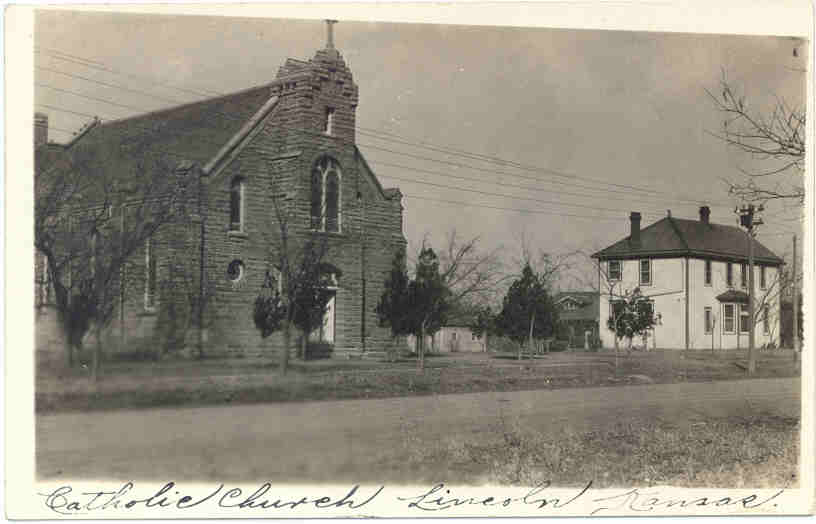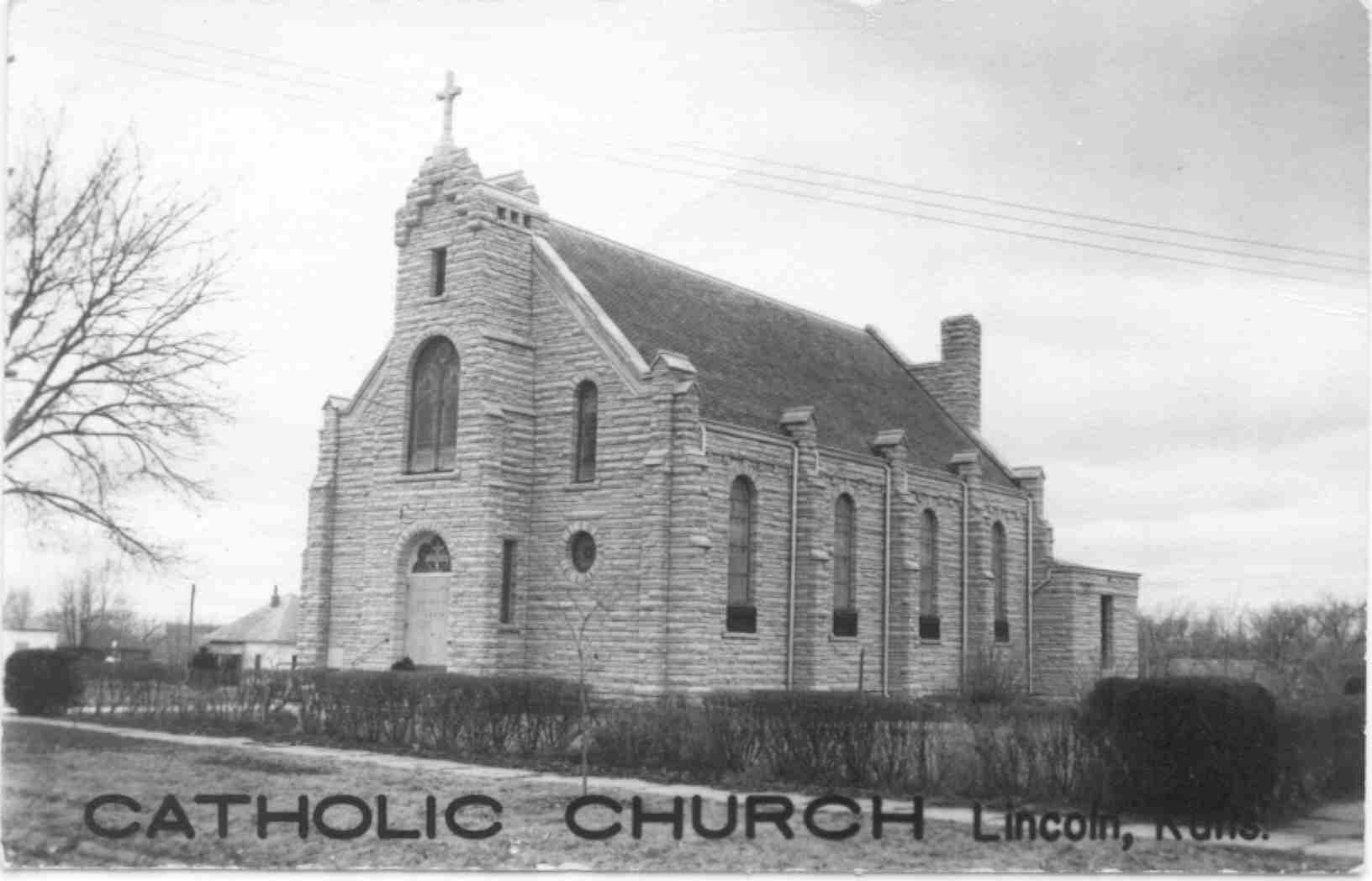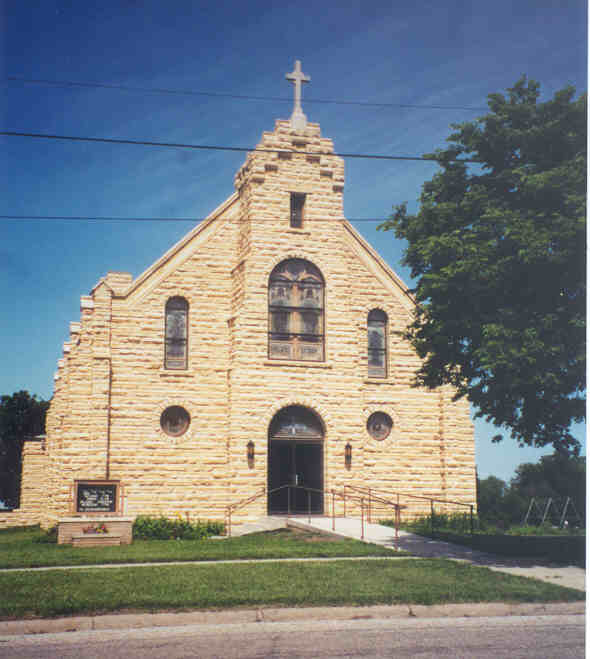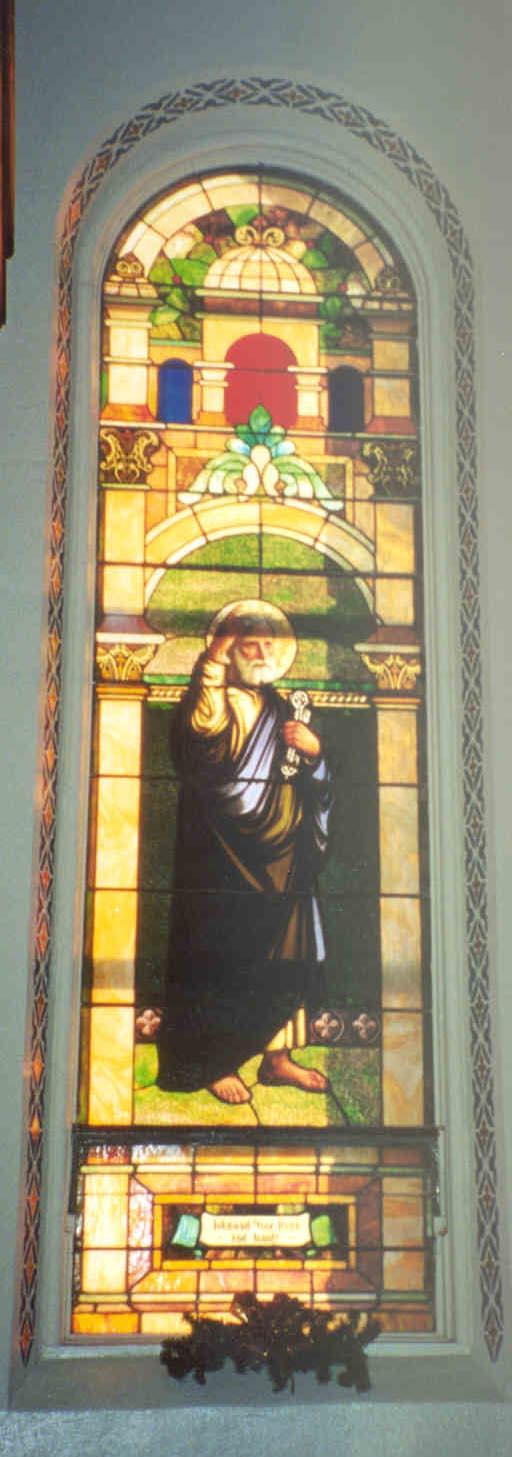ST.
PATRICK'S
The Catholics built their first church building in Lincoln
in 1878. This is the second church, which was dedicated in 1907. Next to the
church is the parsonage.
 ST.
PATRICK'S
ST.
PATRICK'S
This is another view of the church and parsonage.
 ST.
PATRICK'S
ST.
PATRICK'S
Another view of the church; the parsonage has been removed.
Today there is a parsonage with meetings rooms in the basement to the left
(south) of the church.
 ST.
PATRICK'S
ST.
PATRICK'S
The interior of St. Patrick's was remodeled extensively in
the 1970s.
 ST.
PATRICK'S
ST.
PATRICK'S
St. Patrick's Church as it looks today (taken in 2002).
 STAINED
GLASS WINDOW, ST. PATRICK'S
STAINED
GLASS WINDOW, ST. PATRICK'S
One of the stained glass windows in St.
Patrick's. The Celtic symbols painted around the windows are reminiscent of the
church's Irish heritage. The windows were paid for by some of the original
founds of the church; this one was sponsored by the Ryan family.
(Taken from The Lincoln Sentinel-Republican, date of issue unknown.
Written by Helen Flaherty. Submitted by by Tracee Hamilton.
The Union Pacific Railroad completed the union of the Atlanta and Pacific coasts when it finished 3,300 miles of track in 1869. To encourage the railroad to build this line, the government gave certain sections of land 20 miles north and 20 miles south of the proposed line, and the railroad company disposed of this land at $1.25 per acre. To encourage settlers, the government gave 160 acre homesteads and timber claims if certain conditions were fulfilled.
As a result of dissatisfaction with English rule, many of the people of Ireland immigrated to the United States. Many being poor, it was a necessity for them to find employment as soon as possible. The railroad provided work for many who were seeking jobs.
A number of the first Irish settlers of Lincoln county had first located in Junction City and Ellsworth. As there was a chance to take up homesteads and buy railroad land cheap, many of these people came to Lincoln county to acquire land homes of their own locating along the Saline River.
Pioneer Families..........
The first Irish to settle in Lincoln county were the Michael Healys and Peter King, followed by Mr. Healy's mother, brothers, the Kings, Laffertys, Patrick and Thomas Noon with their families, the O'Tooles, Flahertys, Whalens, Foleys, Forans, Kellys, Mulloys, Corrigans and Kilcoynes. A short time later the Dillons and the Downey brothers arrived. Francis, one of the Downey brothers, was the first Catholic to locate in Lincoln Center (ed. note
' now Lincoln) in about 1884. Shortly thereafter the Gallaghers and Dunns moved to that town from Lindsborg, Kan.
Other Catholic pioneer families were the Ackermans, Jaskes, Smiths, Zink, and others who were not Irish. Many of them came from Russia, Germany and other European countries to improve their lot in free American.
First Mass and First Church............
Around 1870, the Rev. John Fogarty of Junction City was one of the first priests to come to Lincoln and vicinity with any degree of regularity. In 1872 the Rev. Henry Temphaus, Beloit, said Mass in Lincoln. There was no church in Lincoln at this time. The Rev. Adolph Wibbert of Salina came to Lincoln from 1875-1878. When the Rev. Bernard Nuttman of Ellsworth began to serve Lincoln in 1878, the people considered building a church, and the city of Lincoln Center generously gave a whole block for that purpose. The first church was constructed partly of native cottonwood brought from Ellsworth and sawed on a local sawmill. Father Nuttman was succeeded by the Rev. T. Lager until 1880.
The Rev. P. O'Connor was here for the next two years, but died then of injuries received when thrown from a horse.
The Rev. John Kelly of Ellsworth ministered to the Lincoln Center needs from 1882-1883. It was during his time that the Most Rev. Louis Fink, Bishop of Leavenworth, came to administer confirmation for the first time. A Father Brockart cared for Lincoln the following year and he was in turn followed by the Rev. Anthony Carius, Ellsworth, an ex-Civil War chaplain. Father Carius served till 1888.
Vesper Parish............
The Union Pacific railroad had passed through Lincoln county by this time and Vesper, a few miles west of Lincoln Center, was becoming a thriving center. There were several Catholic families with small children in the vicinity, so it was decided to build a church. Mr. and Mrs. John O'Toole donated a 2-acre tract as a site and St. John's church was built in 1887. An altar patterned after the one in the present Lincoln Church was made and donated by J.I. Flaherty.
During the Rev. C. Maujay's pastorate which lasted until 1892, Mass was scheduled regularly for the 1 and 3 Sundays. The Sacrament of Confirmation was administered by Bishop Hennessy of Wichita in 1892. (Ed. note Bishop Hennessy was serving as administrator of the Concordia Diocese during an interregnum.)
The Rev. John Regan had his home in Delphos and drove to Lincoln and Vesper in a top buggy for the next four years. The Rev. J. Corrivault, coming from Canada for reasons of health, served about a year.
First Resident Priest............
The Rev. John McNamara was first resident priest who served the parish until 1906. The rectory, still in use, was built in 1901. A leave of absence was granted Father McNamara to visit Ireland and the Rev. Joseph Conway was his substitute.
Present Church............
In 1904 it was decided to build a church of native limestone and the cornerstone was laid by the Rev. John Maher, Salina, in 1905. A Mr. John L. Larsen, though not a member of the parish, did most of the masonry work. He died within the past year at the age of 90.
A succession of pastors followed Father McNamara, with a Father Donovan serving in 1907, the Rev. John McGinnes until 1911 and the Rev. (now Rt. Rev. Monsignor) Michale Mulvihill the following year. The Rev. John Fitzgerald (now retired in Herington) served as pastor until 1922.
The Rev. John R. Fox succeeded Father Fitzgerald and served intermittently until 1930. Because of Father Fox's ill health a large number of priests substituted from time to time, including the Rev. (now Rt. Rev. Monsignor) Michael Drieling. The Jesuits from St. Mary's often filled in during this time.
In 1930 the Rev. Daniel B. Mulvihill because pastor and held it for 13 years, the longest tenure of any pastor of St. Patrick's.
Improvements
There was no bell in the belfry of St. Patrick's, and the late Frances Shepard, president of the Ladies Guild in 1938, was instrumental in obtaining a 300-pound locomotive bell from the Union Pacific Railroad without cost. Miss Shepard worked through T.L. Murray, then local agent, and W.S. Markle, former agent, having the bell sent from Omaha. The bell rang out for the first time at 1938 midnight Mass.
The Rev. John W. Whitty succeeded Father Mulvihill in 1943 and remained until 1946. During his pastorate tilling was laid in sanctuary and sacristies, kneeler pads were installed, and a new roof put on the church.
For a short time in 1946 a shortage of priests caused Lincoln to become a mission of Beloit. In January 1947, the Rev. George F. Breckwell was appointed pastor of St. Patrick's and was instrumental in accumulating funds for future redecoration of the church as well as installing a new furnace.
Vesper closed
Since the Vesper mission had been unattended for some time, and inasmuch as a wind storm had damaged the church, it was decided to sell the building and land in 1948.
The next pastor for the Rev. Adolph Hecker, appointed in 1952. During his pastorate the church was completely redecorated on the inside, the exterior of the church was sandblasted, and treated to preserve its original limestone finish, and the rectory was remodeled.
In April of 1958 the Rev. John Vandenberghe was appointed to Lincoln and remained until June 1961. While in Lincoln Father Vandenberghe was responsible for the building of a $25,000 parish hall constructed of blocks made at the local Quartzite Stone Co., and with a brick veneer facing.
The Rev. Eugene Stehno came to Lincoln in 1961 to succeed Father Vandenberghe, but was transferred to Concordia by reason of the serious illness of the Rt. Rev. Monsignor Emil Duchene in February 1962. The parish was attended by the Rev. Philip Lamberty, O.P., an instructor at Sacred Heart High School, Salina, by the Rev. John Shaulis, Chicago, and the Rev. Roger Meitl, Plainville.
St. Patrick's, which extends over most of Lincoln County, is among the largest territorial parishes in the diocese. There are two cemeteries in the parish, one south of Lincoln and the other the Vesper cemetery near Vesper.
(Much of the data for this historical sketch was supplied by Miss Anne Dillon, Lincoln, a pioneer member of the parish.)
This article was transcribed by Tracee Hamilton.
St. Patrick's Catholic Church Dedication
"Dedication of Catholic Church"
From the Lincoln Sentinel, June 20, 1907
On June 7, 1907, St. Patrick's Catholic church at Lincoln was dedicated. The ceremony of dedication began promptly at 10 o'clock in the morning and was witnessed by a large crowd of people.
Bishop Cunningham, of Concordia, Kansas, performed the ceremony assisted by Fathers Maher, McNamara, O'Riley, Glynn, Luckey and Pierere.
Immediately following the dedication Solemn High Mass was celebrated the first in the new church, then followed the confirming by the Rt. Rev. Bishop of a class of twenty, the services closing with benediction.
The interior of the new church was an object of admiration of all present regardless of religious belief. The choir under the careful training of Dr. Rucker rendered the difficult mass in a highly pleasing manner. The following persons composed the choir viz. Mrs. Margaret Whalen, Misses Julia Mulloy, Emma Ryan, organist Maggie Mulloy, Mrs. Lyon, Mrs. Minx, Dr. Rucker, James and John Mulloy. Rev. Father Maher, of Salina, Kansas, delivered the sermon and impressed his audience as a man of singular eloquence and ability. In the course of his closing remarks he expressed many words of thanks and appreciation to the non-Catholics who have so generously assisted in the building of the new church.
"History of St. Patrick's Bell"
From the Lincoln Sentinel, Jan. 26, 1939
History of St. Patrick's recently acquired bell was received last week in a letter to W.S. Markle, U.P. agent at Sylvan Grove, from C.P. Cahill, superintendent of the Omaha division. A portion of the letter follows:
"Donation of this bell was approved by Mr. J.W. Burnett, General Superintendent Motive Power and Machinery, Omaha, Neb., and Mr. N.A. Williams, General Manager, Omaha.
"The bell was released from switch engine 4403, which was built in April 1913 by Baldwin Locomotive Company, and retired from sevice in December 1936, this engine having performed service in various yards on Nebraska Division, such as Omaha, North Platte and Cheyenne.
"Tractive effort of this engine was 27,276 pounds, weight 154,682 pounds, as compared with tractive effort of 39,1000 and weight of 165,000 pounds of the more modern switch engines."
Many of the earliest members of St. Patrick's Catholic Church in Lincoln purchased stained glass windows or plaster Stations of the Cross for the building, either as a donation or in memory of a family member. The following is a list of purchasers of windows and Stations of the Cross.
Windows
Mrs. John Gallagher (over interior doors into church)
Choir of 1906 (upstairs in choir loft)
Philip and Bertha Ackerman (upstairs in choir loft)
James, John and Joseph Garrity (upstairs in choir loft)
John Whalen and Family (over the outer entrance to the church)
Nicholas and Margaret Whalen (rear of church)
Edmund and Bridgid McNamara
John and Anne Ryan and family
Sister Octavius McCurdy
P.J. and R.T. Ackerman
John, Margaret and Mary Dunn
Timothy and Sarah Foran
James Mulloy Jr. (rear of church)
Mrs. Frank Cornellison
Michael and Margaret Haley (in foyer)
Robert and Bridgid Dudley (in foyer)
Stations of the Cross
I St. Patrick's Knights of Columbus
II St. Patrick's Altar Society
III Michael haley Sr. and Francis L. Haley
IV Mrs. A.E. Achterberg and family
V (In memory of) James W. and Agnes M. Dillon
VI Henry Zink and family
VII Donated by the Sarto Club
VIII St. Patrick's Parish
IX Catholic Ex-servicemen of Lincoln Co.
X Owen Healy and family
XI Tim Foran and family
XII Michael Follard
XIII (In memory of) Bridget C. McCurdy
XIV Young Ladies Sodality
"St. Patrick’s Corner Stone Laid 50 Years Ago"
From the Lincoln Sentinel-Republican, 1 September 1955
Fifty years ago, Aug. 31, 1905, the cornerstone of the present St. Patrick’s Catholic church in Lincoln was laid, and the following report of the event, written at the time of the laying of the corner stone, will be of interest at this time.
The church was built of native limestone rock, and like many other edifices built from the same material throughout this section, it has withstood the vicissitudes of the changing conditions of the Kansas elements, and today stands as imposing as the day it was built.
The narrative of the laying of the corner stone follows:
The laying of the corner stone of the splendid new Catholic church in this city last Thursday, Aug. 31, 1905, was an important event in the history of the Catholic church in Lincoln county.
The Very Reverend Father Maher, of Salina, was in charge of the ceremony and was assisted by Father McConnel of Plainville, Father Flemming of Solomon and Father McNamara, pastor of the local parish. The ceremony was beautiful and impressive in its very simplicity.
The stone itself is a beautiful blue granite and was donated to the church by Henry Sahlman, who also cut and engraved it. The stone bears the simple inscription, “St. Patrick, 1905,” included in the tin box which is securely bedded in the stone are several matters which will be of interest to future generations when for any cause the stone shall be removed and the contents opened up. The contents consist of a copy of each of the Lincoln papers, the Republican and the Sentinel; a history of the bishop and of the dioceses; a history of the old settlers of the congregation, telling of their hard work and hard times of the early days as well as the change [to] present affluence and comparative east; a short sketch of the present form of state and national government, giving the names of the present governor of Kansas and the president and paying tribute to President Roosevelt as the best president since Lincoln; and a short history of our city, estimating our present population at from 1,400 to 1,500.
Father Maher delivered the address of the occasion and made a splendid effort. He traced the history and significance of the corner stone laying through the ages, paying glowing tribute not only to those who have lain corner stones of imposing edifices, but also to the great characters whose lives and teachings have been the corner stones of truth, intelligence and virtue. He traced especially the work of the Catholic church in Kansas from the first appearance of that missionary, who laid down his life on Kansas soil away back in the year 1542 to the present time with the many benevolent and charitable institutions supported by Kansas Catholics. ...
The building itself will be a handsome stone structure with a seating capacity of 300 and is to be completed before cold weather, at a total cost of about $10,000. The stone is bedded in cement up to the water table making a building which should last for centuries, being a monument to the energetic labors of the pastor. Father McNamara, who has been in charge of the church now for almost eight years. Three years ago, he built the parish house and since then has been a resident in Lincoln, having lived in Salina the first five years he was in charge of the church.
The old building which now gives place to the new, erected 28 years ago, when times were hard and money scarce and necessarily correspond with the means and ability of the community, but now that the community has prospered in material things and the individual communicants are well housed and supplied with the good things of this world, Father McNamara was no longer willing that their place of worship should be less imposing, and as his congregation agreed with him, the new church is the result.
The old building will be sold and removed from the block.
Anne Dillon, a long-time member of St. Patrick’s church, and who was present at the corner stone laying, has written an article entitled, “Early Memories of My Church,” in which she recounts many interest incidents. It follows;
Back in the [18]‘60s the Catholics of Lincoln county were served by priests from Salina. The first I know of was Fr. Temphaus, but that was years before my parents, Mr. and Mrs. James W. Dillon, came to the U.S.A.
Then there was Fr. Adolph Wilbert. He it was who established the first Catholic school in Salina, long before there were any Sisters there. He taught the children himself with the assistance of a lay teacher.
When the Catholics decided to built a church in Lincoln the city very generously gave them a whole block, which is still in possession of the church.
But for years we had no resident pastor, being served by priests from Wilson and Salina, but mostly from Ellsworth.
In 1900 the rectory was built and Fr. John McNamara came to Lincoln, our first resident pastor.
The stone in the new church is all native, having been obtained from quarries four or five miles north of Lincoln. I think the quarry was operated by a man named Van Valkenburg, but I am not sure of that. My father, James W. Dillon, John Whalen and Thomas Corrigan were the committee that assisted Fr. McNamara.
Some, at least, of the stone was brought from the quarry to Lincoln by the parishioners, for my two brothers drew some of it. Our house was about nine miles from the quarry. The roads were mere trails, compared with the present ones and there was no modern machinery to load the heavy stones. Horses provided the power. It was, indeed, an arduous task.
The late Owen Mulloy and Michael Cannon helped with the masonry work and Henry Zink, now deceased, who operated a bakery and restaurant, provided free meals for any of the workers who wished to go there.
Although I mention a few, all helped, included people how were not Catholics, many of whom contributed liberally and helped to make money-making entertainments a success.
I will remember that memorable day how we all sat happily on planks in to the hot August sun watching the ceremonies and listening intently to Fr. Maher’s eloquent sermon. Few are left who were there that day but the beautiful church stands, a monument to their faith, zeal and generosity.
 ST.
PATRICK'S
ST.
PATRICK'S ST.
PATRICK'S
ST.
PATRICK'S ST.
PATRICK'S
ST.
PATRICK'S ST.
PATRICK'S
ST.
PATRICK'S STAINED
GLASS WINDOW, ST. PATRICK'S
STAINED
GLASS WINDOW, ST. PATRICK'S